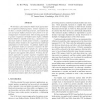179 search results - page 10 / 36 » Structure recognition on sequences with a neuro-fuzzy-system |
PR
2010
13 years 7 months ago
2010
Wavelet analysis has found widespread use in signal processing and many classification tasks. Nevertheless, its use in dynamic pattern recognition have been much more restricted ...
ECML
2007
Springer
14 years 17 days ago
2007
Springer
Recently, a successful extension of Principal Component Analysis for structured input, such as sequences, trees, and graphs, has been proposed. This allows the embedding of discret...
CIARP
2009
Springer
14 years 3 months ago
2009
Springer
Many tasks can be described by sequences of actions that normally exhibit some form of structure and that can be represented by a grammar. This paper introduces FOSeq, an algorithm...
IBPRIA
2009
Springer
14 years 1 months ago
2009
Springer
Abstract. Being an essential key in biological research, the DNA sequences are often shared between researchers and digitally stored for future use. As these sequences grow in volu...
CVPR
2006
IEEE
14 years 10 months ago
2006
IEEE
We introduce a discriminative hidden-state approach for the recognition of human gestures. Gesture sequences often have a complex underlying structure, and models that can incorpo...

